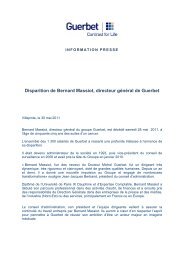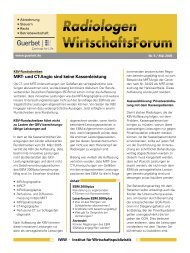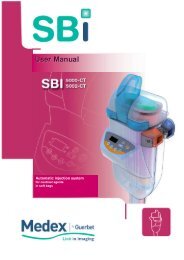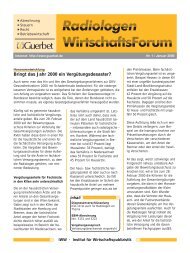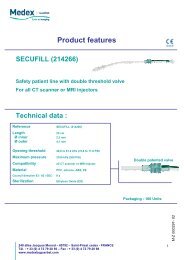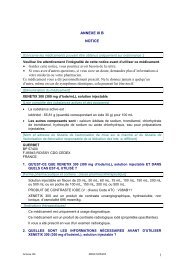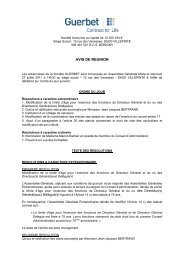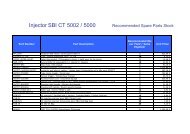Read the Registration Document - Guerbet
Read the Registration Document - Guerbet
Read the Registration Document - Guerbet
Create successful ePaper yourself
Turn your PDF publications into a flip-book with our unique Google optimized e-Paper software.
p) ProvisionsProvisions correspond to liabilities that meet <strong>the</strong> following criteria:- Uncertain timing or amount;- The economic impact for <strong>the</strong> Group is negative, i.e. this liability is analysed as a Groupcommitment to a third party for which it is probable or certain that it will result in an outflow from <strong>the</strong> Groupof resources embodying economic benefits to settle <strong>the</strong> obligation, without receiving in exchangeconsideration of a value at least equivalent to <strong>the</strong> latter.To manage its interest rate exposure, <strong>the</strong> Group has recourse to options recorded at fair value inaccordance with IAS 39. Changes in fair value of <strong>the</strong>se financial instrument are recognised in <strong>the</strong> incomestatement under "Finance costs".q) Employee benefitsIn accordance with <strong>the</strong> laws and practices applicable in <strong>the</strong> countries where <strong>the</strong> Group operates, employeesmay qualify for retirement indemnities.Retirement indemnities are measured in compliance with IAS 19.For defined contribution plans concerning post-employment benefits, costs are estimated according to <strong>the</strong>method of <strong>the</strong> projected unit credit method.This method is based on benefits payable to employees on <strong>the</strong>ir expected date of retirement taking intoaccount <strong>the</strong> age pyramid, rate of employee turnover, mortality rates on <strong>the</strong> basis of actuarial tables by agebracket. The amounts are revalued according to assumptions concerning inflation and promotions anddiscounted in respect to <strong>the</strong> date benefits will actually be paid.When <strong>the</strong> assumptions on which calculations are based are revised, actuarial gains and losses arerecorded under equity.All plans are remeasured once year.r) Financial instrumentsThe Group trades in financial instruments to manage and reduce interest rate and foreign exchangeexposures. These instruments are traded with investment grade financial institutions. Under IAS 39recourse to hedge accounting requires that its effectiveness must be demonstrated and documented frominception and throughout <strong>the</strong> life of <strong>the</strong> hedge.The effectiveness of <strong>the</strong> hedge is evaluated in relation to <strong>the</strong> changes in <strong>the</strong> value of <strong>the</strong> hedge and <strong>the</strong>hedged item that must remain between a range of 80% and 125%.Financial instruments are recognised in <strong>the</strong> balance sheet at market value on <strong>the</strong> closing date. Changes in<strong>the</strong> value are recognised on <strong>the</strong> basis of <strong>the</strong> following principles:- For cash flow hedges, changes in fair value are recognised under shareholders' equity for <strong>the</strong>effective portion and <strong>the</strong> ineffective portion is recognised in <strong>the</strong> income statement;- For fair value hedges all changes in fair value are recognised in <strong>the</strong> income statement.Market value is determined on <strong>the</strong> basis of <strong>the</strong> trading price of third-party establishments and verified by afirm specialised in financial instruments. Changes in fair value of financial instrument derivatives arerecognised in <strong>the</strong> income statement under "Finance costs" for interest rate derivatives and under “Currencygains (losses)” for foreign exchange derivatives.s) Revenue recognitionRevenue is recognised when significant risks and rewards incident to ownership have been transferred to<strong>the</strong> buyer. Revenue is recognised net of cash discounts granted.t) Investment grantsInvestment grants are not recorded as a charge to fixed assets acquisition costs but instead under deferredrevenue. They are written back to o<strong>the</strong>r operating income on <strong>the</strong> basis of <strong>the</strong> depreciation of <strong>the</strong>corresponding fixed assets financed by <strong>the</strong>se grants. Special grants received to support innovation and job80




